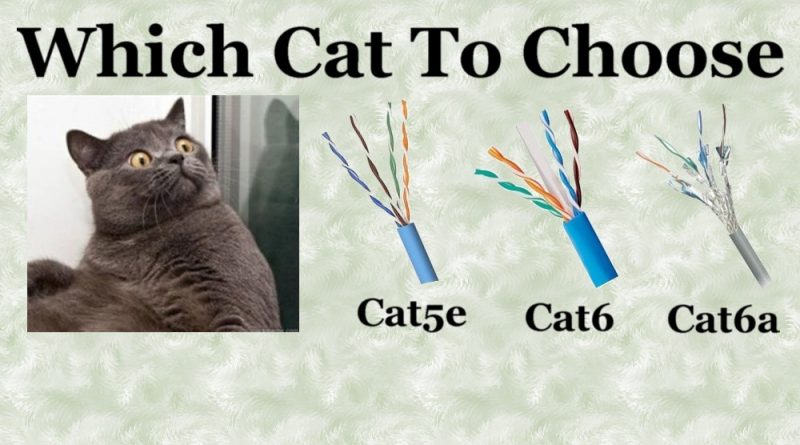Ethernet Cable Types Made Simple
Are you confused by the many different types of ethernet cable. We at Stoneleigh Consultancy Limited will make choosing the right cable for your business infrastructure easy.
Different specifications of Ethernet Cable to keep in mind when choosing your network cable:
- Shielding from electromagnetic interference.
- Data transmission speed.
- Possible bandwidth frequency range required to achieve optimum speed.
| Category 3 cable or Cat 3 also know as Voice-Grade (VG) is an unshielded twisted pair (UTP) most commonly used in telephone wiring. Reliable up to 10 Mbit/s. Cat 3 cable was most commonly used in the early 1990’s but modern data networks run at much higher speeds which lead to Cat 3 giving way to Cat 5e and Cat 6 cabling. | Category 5 (Cat 5) is the successor to the earlier Category 3. Like Cat 3, it is a UTP cable, but it is able to carry data at a higher transfer rate. Cat 5 cables introduced the 10/100Mbps speed to the Ethernet, which means that the cables can support either 10 Mbps or 100 Mbps speeds. A 100 Mbps speed is also known as Fast Ethernet, and Cat 5 cables were the first Fast Ethernet-capable cables to be introduced. They also can be used for telephone signals and video, in addition to Ethernet data. This category has been superseded by the newer Category 5e cables. |
| Category 5e standard is an enhanced version of Cat 5 cable, which is optimized to reduce crosstalk, or the unwanted transmission of signals between data channels. This category works for 10/100 Mbps and 1000 Mbps (Gigabit) Ethernet, and it has become the most widely used category of Ethernet cable available on the market. While Cat 5 is common in existing installations, Cat 5e has completely replaced it in new installations. While both Cat 5 and Cat 5e cables contain four twisted pairs of wires, Cat 5 only utilizes two of these pairs for Fast Ethernet, while Cat 5e Ethernet Cable uses all four, enabling Gigabit Ethernet speeds. Bandwidth is also increased with Cat 5e cables, which can support a maximum bandwidth of 100 MHz. Cat 5e cables are backward compatible with Cat 5 cables, and can be used in any modern network installation. | Category 6 cable, One of the major differences between Category 5e and the newer Category 6 is in transmission performance. While Cat 5e cables can handle Gigabit Ethernet speeds, Cat 6 cables are certified to handle Gigabit Ethernet with a bandwidth of up to 250 MHz. Cat 6 cables have several improvements, including better insulation and thinner wires, that provide a higher signal-to-noise ratio, and are better suited for environments in which there may be higher electromagnetic interference. Some Cat 6 cables are available in shielded twisted pair (STP) forms or UTP forms. However, for most applications, Cat 5e cable is adequate for gigabit Ethernet, and it is much less expensive than Cat 6 cable. Cat 6 cable is also backwards compatible with Cat 5 and 5e cables. |
| Category 6a cable, or augmented Category 6 cable, improves upon the basic Cat 6 cable by allowing 10,000 Mbps data transmission rates and effectively doubling the maximum bandwidth to 500 MHz. Category 6a cables are usually available in STP form, and, as a result, must have specialized connectors that ground the cable. | Category 7 cable, also known as Class F, is a fully shielded cable that supports speeds of up to 10 Gbps (10,000 Mbps) and bandwidths of up to 600 Mhz. Cat 7 cables consist of a screened, shielded twisted pair (SSTP) of wires, and the layers of insulation and shielding contained within them are even more extensive than that of Cat 6 cables. Because of this shielding, they are thicker, more bulky, and more difficult to bend. Additionally, each of the shielding layers must be grounded, or else performance may be reduced to the point that there will be no improvement over Cat 6, and performance may be worse than Cat 5. For this reason, it’s very important to understand the type of connectors at the ends of a Cat 7 cable. |
| Speed | |||||||
| Mb/s | GB/s | ||||||
| Cable Category | Usage Length | 10 | 100 | 1 | 10 | POE | Mhz |
| Cat-5 | 100 | yes | yes | no | no | yes | 100 |
| Cat-5e | 100 | yes | yes | yes | no | yes | 100 |
| Cat-6 | 100 (55 for 10GB/s) | yes | yes | yes | yes | yes | 250 |
| Cat-6a | 100 | yes | yes | yes | yes | yes | 500 |


